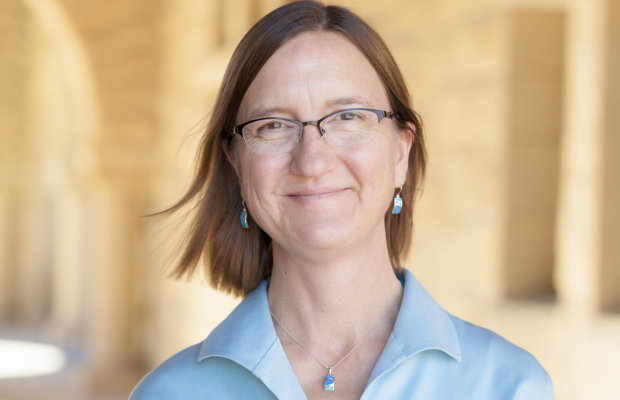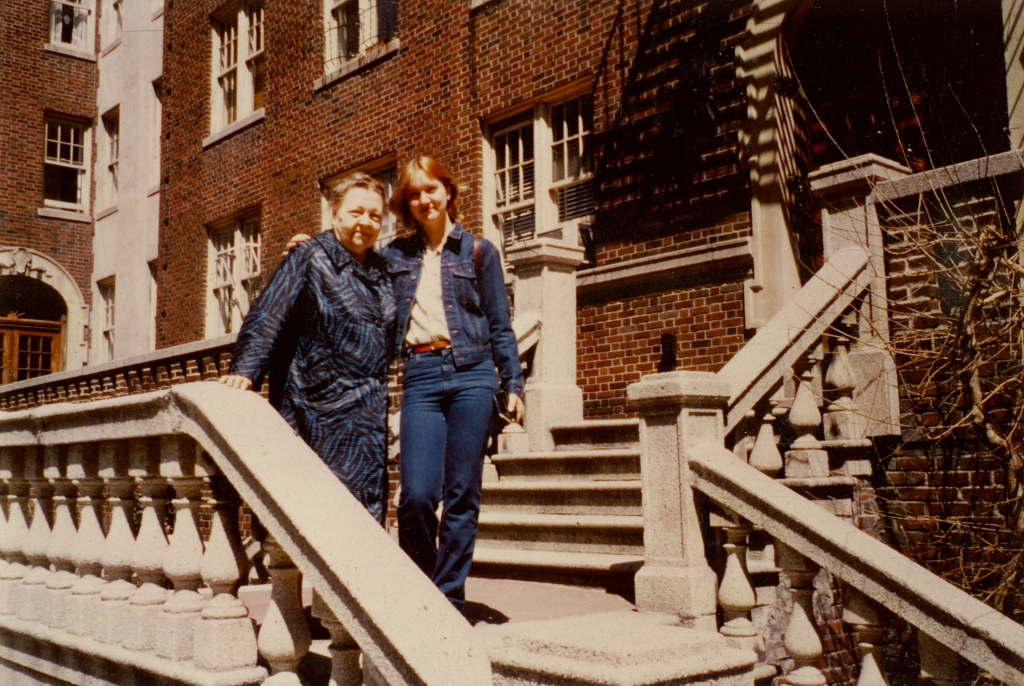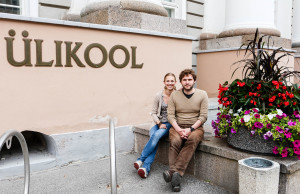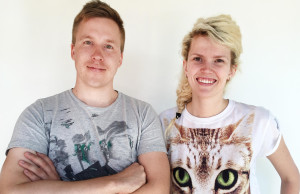From New York to Tallinn to Stanford

While working as a PR-person for one of the best universities in the world, Lisa Trei is also an unofficial ambassador of Estonia, introducing her country to Stanford and teaching local Estonians the art of effortless networking.
The first time I met Lisa Trei was at an Estonian event in mid-winter in downtown Palo Alto. Wearing a thick blue-and-red jumper in a distinctive Kihnu pattern – the weather was as cold as it ever gets in the Bay Area – she walked right up to me and said in fluent Estonian: “We have not met before but I know you because my late father’s wife is a friend of your mother-in-law.”
For a moment there I was really puzzled. Yet that felt so heartwarmingly Estonian. Because it’s so common to know someone’s friend’s friend and eventually we are all somehow related. Sharing the same trade, both being journalists, I sensed that I immediately clicked with her.
It was only later that I found out that Lisa’s heritage story is more colorful than just being Estonian. Her mother, Peggie, is an American and, while Lisa was born in the land-of-the-free, she grew up in different parts of Europe as her parents were constantly on the move. Lisa went to Estonia for the first time in 1985 and then moved there at the end of the Soviet era. She learned the language as an adult, then got married and decided to stay. Those were heady times to be immersed in Estonian society, especially if one happened to be a reporter.
Now Lisa has been back in the US for almost two decades and has slightly departed from her roots as a journalist. But she’s a superwoman nevertheless. For the past 18 years she has been working at Stanford University, while juggling life as a single parent of three teenage daughters and commuting to campus from San Carlos every day. Previously a staff writer at Stanford News Service and public affairs manager at the Center for International Security and Cooperation, her current job title is Associate Director of Communications at the School of Humanities and Sciences, which means she supports fundraising for the university’s largest school. More specifically, she works in external communications, helping Stanford maintain its public image as one of the world’s top universities while also raising hundreds of millions of dollars from alumni and philanthropic donations.
From one island to another one
Despite her prestigious work Lisa is a very down-to-earth person who is proud of her humble roots. “I look like my Estonian grandmother,” she admits about a photo a friend has posted on Facebook. Indeed, physically she looks very much like Alice Rosalie Trei, who was a typical hardworking Estonian of few words born in 1909 in Lümanda, a small village on the island of Saaremaa. Alice crossed the Atlantic Ocean in 1929 to get married to her distant cousin who had moved to America a few years earlier, arriving in New York City three days after the stock market crashed that led to the Great Depression. Accustomed to the hardships of her time, Alice found work in a laundry house and as a seamstress. Later, her husband Peter worked as a building superintendent in the Bronx and Manhattan, and the couple ended up buying a 55-unit apartment in northern Manhattan where they lived for the rest of their lives. Dozens of Estonians who escaped their homeland in 1944 and came to America as refugees in the 1950s, lived in the house on Sickles Street.

Alice and Lisa Trei outside the Sickles Street house, circa 1976 (Photo from Alice’s personal collection)
This building is where Lisa’s father, Alan, grew up and where Lisa lived when she was a graduate student at Columbia University’s School of Journalism. Lisa recalls her grandmother in those days: “I loved her dearly even when she just stared at me in silence as we sat together in her Manhattan kitchen. When I asked her why she did this, her deadpan response was typically Estonian: ‘There’s nothing better to look at.’”
“She always told me that all Estonians in America are hardworking, go to college and never drink,” Lisa also remembers. It did not take her too long to realize this was not always the truth.
Although her grandmother Alice never returned to her native Saaremaa, Lisa and her dad, Alan, were among the first Westerners to visit the island in 1989. Located on the western border of the USSR, Saaremaa was a closed military zone during the Soviet occupation. But thanks to the land restitution laws after Estonia regained statehood, the family ended up getting back the lands near where Alice was born 80 years earlier.
Lisa’s family still owns property in northwestern Saaremaa. The very character of Estonians and their special relation to work and owning land has never been described better than in Anton Hansen Tammsaare’s “Truth and Justice,” which Alan Trei translated into English with his second wife Inna Feldbach. As love for literature runs in the family, Lisa is pondering the idea of writing her own book based on her grandmother’s tale, which embodies the central idea of Tammsaare’s novel: “If you work hard, you’ll find love.”
Crazy times call for crazy people
As Lisa grew up, her parents moved around a lot. Originally from New York, the family lived in five countries in Europe from 1965 to 83 (Sweden, England, Denmark, Belgium and Switzerland) and Lisa and her brothers always made an effort to learn the local language. Lisa graduated with a degree in Social and Political Science (SPS) from Cambridge University but then decided to move back to New York.
After college, Lisa worked as an assistant for a labor columnist who had been blinded by a mobster for covering New York’s organized crime families. She also became deeply involved in the labor movement, reporting for the International Ladies Garment Workers’ Union. This was the time when factory jobs started to move across the sea to China and local unions needed every piece of positive news to support American garment workers. Since sharing “only good news” at the time of economic turmoil was difficult, Lisa became disillusioned with the union work and decided to learn “serious” journalism, which led to her Columbia studies and to hearing about Estonia in her grandmother’s Manhattan kitchen.
Columbia University was where in 1990 she met Marju Lauristin, one of the cofounders of the pro-independence movement the Popular Front, who was there for a conference. Lauristin was so persuasive that six months later, Lisa found herself in Estonia, teaching classes like Beat Reporting and Investigative Journalism at Tartu University. Unfortunately, she was long gone when I became a student there in 1998 but one could still sense a special yearning for the “good” American-style media in the back-end corners of the main building of the oldest university in Estonia.
While Lisa was originally supposed to stay in Estonia only for 6 months she ended up staying there for 6 years. Besides lecturing the students, she worked for the Estonian Independent and freelanced for The Wall Street Journal (WSJ) and other international outlets hungry for news from former Soviet Republics as they broke away from the evil empire and rebuilt their independent states.
Lisa remembers an interview from July 1989 when she asked Paul-Eerik Rummo, a poet and a household name in political activism and later a minister of culture, how long it would take Estonia to regain its independence.
“In five years,” Rummo predicted, which at the time must have sounded overly optimistic.
Just two years later, on the night of August 20th 1991, Lisa was in Tallinn, this time listening as parliamentarians on Toompea, the seat of the Parliament, voted for the declaration of re-independence. What had seemed almost impossible in 1989 became true much sooner than anyone dared to believe.
Becoming repatriated
As the newly re-independent state struggled, so did Lisa. Despite her roots, it was not easy to become acquainted with fellow Estonians since she spoke no Estonian and, to her dismay, she discovered that almost nobody spoke any English. “It was a very lonely time but I was very motivated to learn the language, which I finally did after about two years thanks to the wonderful Oks family I lived with from 1992-93 in Tallinn and my boyfriend, now ex-husband, who didn’t speak English.”
Lisa remembers how she, as a “foreign-Estonian,” was sometimes regarded as a burden on the society: “It was the time of deficits and there was a lot of stress finding food and ordinary goods every day. People were resentful of those who had “valuuta,” foreign currency, even if there was not really anything to buy with it. They were also resentful of the fact that I could leave Estonia any time I liked. I earned a ruble salary at the Estonian Independent, used special vouchers to buy food (“talongid”), lived in a Soviet-era high-rise suburb in Mustamäe (rented a room in a widow’s flat), didn’t have a car…but still people sometimes really questioned what I was doing in Estonia.
When I told people I wanted to learn about the country my grandmother came from, they would grunt and walk away. My real reason for living there was because I was a journalist and Estonia was an amazing story even if the living conditions were difficult. I didn’t want to work in Moscow because it was crowded with foreign reporters. There were only a handful of western journalists based in the Baltics in those days.”
No wonder she would hang out with the (few) other foreigners, simply because they were much easier to talk to. “I met Lisa through her father, an adventurer and friend of books. I figured she had to be pretty all right if Alan was her father,” remembers Scott Diel, an American who arrived in Estonia in 1992 as a volunteer for the Peace Corps, a US government agency that promotes world peace. Scott still lives in Tallinn where he owns a bookstore and writes a popular column about Estonians seen from a foreigner’s perspective.
Another colleague of Scott’s from the Peace Corps days, Jerry Wirth, who now lives in Riga, Latvia, and owns a summer house on Estonia’s Ruhnu island, also met Lisa around 20 years ago when she was a stringer for the WSJ in Estonia. They often exchanged ideas on subjects that she was writing about as Tallinn was, and still is, a small place and friends often discuss important matters.
“I would describe Lisa as a thoughtful, sunny person,” Jerry writes from Riga. “Thoughtful as someone who is well educated and with a balanced and informed view of the world. “Sunny” I think describes her better than “positive” or “optimistic” or “happy.” “Sunny” encapsulates all those things. Lisa was always someone I looked forward to seeing. That also says a lot about her. I still look forward to seeing her but these days that is usually only through Facebook medium.”
Domesticated by California
In this virtual world in which we live these days, being based in California or Estonia doesn’t really block people from keeping in touch or feeling attached to each other. Especially now as people anywhere in the world can soon apply to become an e-resident without ever physically going to Estonia. Lisa still keeps her attachment more real and tangible.
“I feel fortunate that I was able to contribute to the country’s struggle for independence. I’m thrilled to hold an Estonian passport and I’ve made sure that all my children have them and that they know that Estonia is their home too.” Lisa’s three daughters Sara, Alise and Kaia were all born in California but they go to Estonia every summer to visit their father and keep in touch with their roots.
It’s no wonder that Lisa has built an Estonian society of her own here in California.
“My family moved here in 1998 and soon afterwards I met Lisa as we lived quite nearby and our kids were about the same age,” recalls Leelo Kask, a close friend of Lisa’s. “I think her biggest contribution has been introducing Estonia to the locals here through her work as a journalist and at Stanford. I’m sure she has helped all of these Stanford-affiliated people coming from Estonia to get settled in. To me, personally, she has offered tremendous support both in my personal endeavors and to get my current job as an Estonian language teacher at Stanford.”
Thanks to her radiant personality and sense of mission Lisa also manages to make Estonia look so much bigger than it actually is. As we meet one day on Stanford campus to go to an art event, she introduces me to a colleague who exclaims: “Oh, yet another Estonian! There seem to be so many of you!”
Photo courtesy of Angela Drury.
Loe artiklit ka eesti keeles.












